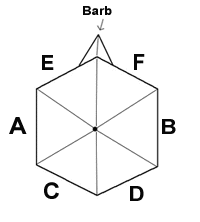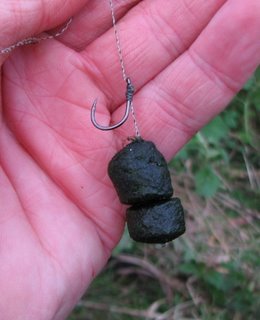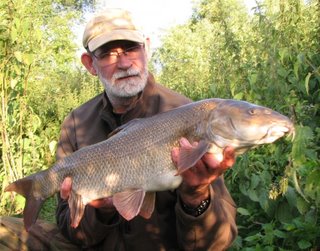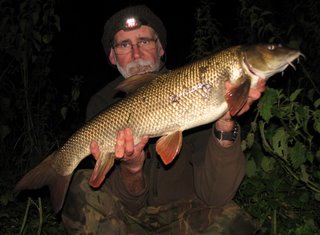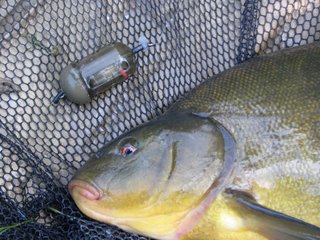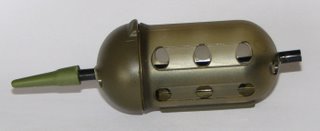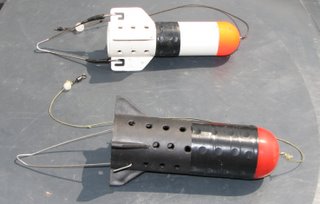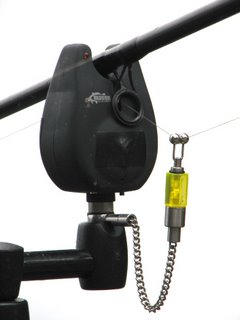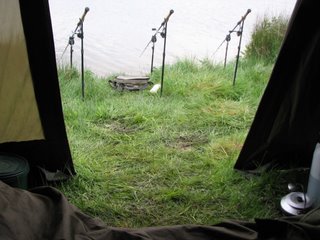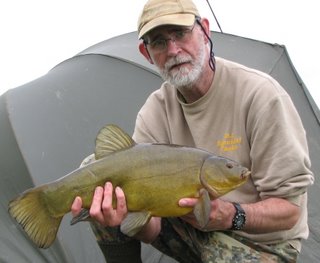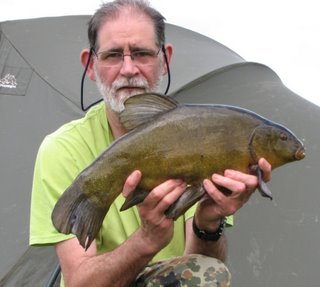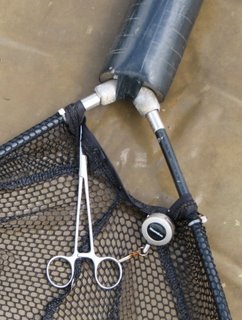After yesterday's session I feel like the England cricket team trying to find hope for the future at the end of another series defeat. What started badly got worse - with a glimmer of hope (like a Flintoff century) in the middle.
The day started decidedly wet, so I went foraging in the supermarket in order to fend off impending starvation. While eating my lunch, after restocking the freezer, the rain eased and the day warmed up. This triggered a barbel fishing response in me. I packed my gear and hit the road. Driving through heavy showers I feared a damp session, but on arriving at the river August was behaving itself with sun shining on the ripe wheat fields, from a blue sky dotted with fluffy white clouds.
With showers forecast I'd packed my brolly, making the trudge downstream hot and tiring with the extra weight and the burning (well, fairly warm) sun beating down on me. Beyond the obvious swims near the road those further down the river looked like they had seen few anglers in recent weeks, some from last season were completely overgrown and hidden by head high Himalayan balsam. On my way to the peg I fancied I threw a few pellets in a couple of the ones that were easily fishable.
On arrival it too hadn't seen many anglers' boots lately. The swim is underneath a willow and quite cramped, so I pushed in the rod rests, positioned my chair and set up the rods on the bank behind the swim. Once ready I cast one rod close in downstream, fishing a Tuff 1 on the hook. The second rod was to be cast across the river close to a bankside bush. That was the intention, but lead, bait and attached bag of pellets went in the branches. I managed to yank them straight back out and they ended up more or less where I wanted them.
I had just started on my second pork pie when the left hand rod, fishing across the river, started bouncing as something dragged the rig out of position. By the time I'd stuffed the remains of the pie in my mouth the debris was well downstream. and as I wound it in it continued kiting towards my other line. The culprit was an uprooted balsam plant. I removed it from both lines, cast out the near bank bait again and rebaited the other rod.
The next cast across the river dropped short. A new bag was attached for the recast which was heading straight for the bush until I stopped it with a jerk that caused the lead to eject from the paper clip. Somehow the hooklink parted too. After retackling I played safe, opting to drop the rig upstream, close in on a crease that had produced a fish for me last year. The underarm swing went well, but the line caught a trailing branch. No problem. Give the line a flick and it will come free. Or get more tangled...
The hook ended up buried in the branch, out of landing net reach, so I had to pull and see what would happen. Now, everywhere else I fish I use 30lb Power Pro as my mainline for barbel. On this small river I have been using mono for some unaccountable reason. Last season it didn't let me down, but I had respooled with slightly lighter line the other day. Nonetheless, 14lb should be enough to cope with any barbel that swims. Of course, I knew that pulling for a break would see the mainline to swivel knot being the weakest link if the hook wouldn't come free. Sure enough another lead went to a watery grave when the line did snap.
Retackling, yet again, the next cast was dropped short of the branch, very close in, and to my surprise a couple of line bites materialised. By now the rain had set in. I was sat in my waterproofs, under the willow, with my recently waterproofed brolly up the bank keeping my rucksack and stuff dry. The session had not started well.
Around seven thirty the rain stopped, signalling time for a move. The gear was soon in place in one of the swims I had baited, a swim that had been kind to me on a few occasions last season. Within fifteen minutes the upstream rod tap-tapped as if a chub was interested in the three pellet 'snake', then the baitrunner sprang into life as the tip pulled right down. A feisty little barbel then charged about under the rod end until it dived into the net. After rebaiting and recasting that rod I checked the downstream bait, only to find it attached to a waterlogged branch.
 The pellet 'snake'
The pellet 'snake'About ten o'clock I felt it was time for a final move to another baited swim. I picked up the upstream rod and it was snagged solid. The mono had no chance. I'd retackle when I got to the next swim. On picking up the downstream rod I found myself in a time warp. I thought it better to retackle both rods where I was to save unwanted flashing around of the head torch in the new swim. It was quarter to eleven when I eventually reached the last swim of the night, with midnight being my designated home time.
This swim is one I have had my eye on since last season, but never fished before. It looks good though with marginal cover and weed to mid-river. The pellet 'snake' was dropped in the margin downstream, and one and a half Tuff 1s cast out beyond the now invisible weedbed. I dragged the lead back across the gravel until it felt spongy, letting the bait, aided by the pellet bag, drift downstream and across towards me. The idea being to get the bait placed right by the outer edge of the weed fronds.
Another rain shower rolled in around eleven forty-five. A quick glance round the back of the brolly showed clearer skies not far away. I'd hang on until it faired off then pack up. Spot on midnight the mid-river rod top pulled over in a positive manner and I was leaning into a fish before the baitrunner had a chance to do its job. This felt a better fish, not powerful like a big fish, but certainly not a four pounder. With no snags to worry about I slackened off the drag a tad as the fish headed downstream under light pressure from the rod. So I have no idea why the line parted at that moment.
That was it. I'd had enough. What a nightmare. Bags packed and off home.
The odd thing is that I hadn't enjoyed my previous two barbel sessions of the season, and started out feeling pretty much the same about this one, but that lost fish has got me fired up to wreak revenge on the whiskery gits!
The negative of the session is that I had been a fool for using mono. I very nearly spooled up with braid, but thought I'd give mono another go - most other anglers seem to use it. They must be idiots...
The positives are rather straw like, in that I'm clutching at them as England do when a batsman makes fifty runs after a run of low scores but they still lose the match. I'd reproofed my brolly with Thompsons Waterseal a few weeks back, and it kept me dry. That was good. I'd tried the 'snake'. That worked. Most importantly I'd found another spot where barbel could be hooked, and there are a few more similar spots on the stretch - including a couple that I don't think see many baits.
Labels: barbel, tips
 If you don't know the film click here
If you don't know the film click here



















